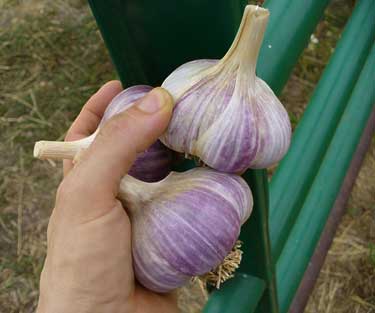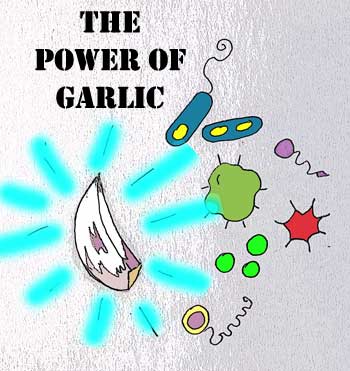Grey Duck Garlic
Garlic Kills Food Poisoning Bacteria
Garlic Compound 100 Times More Powerful than Antibiotics at Combating Food Poisoning Bacteria!
WSU researchers recently reported that diallyl sulfide, a compound found in garlic, is 100 times more effective than the antibiotics erythromycin and ciprofloxacin in killing the toxic bacteria Campylobacter jejuni (Lu et al. 2012).
Campylobacter jejuni is the most common cause of food poisoning in the United States. Food poisoning strikes over 2.4 million Americans each year and symptoms include stomach pains, cramping, diarrhea and fever.
Picture: Boldly striped Washington Bogatyr garlic bulbs are as healthy as they are tasty.
Campylobacter jejuni is hard to kill because it produces a slimy protective biofilm that helps it repels antibiotics and stick to surfaces. The garlic compound diallyl sulfide dissolves the biofilm and kills the cowering bacteria underneath. Diallyl sulfide combines with a sulfur containing enzyme in the bacteria. This changes the enzyme’s function and shuts down cell metabolism; killing bacteria better and faster than antibiotics!
Jakobsen et al. (2012) found that ajoene, a garlic sulfur compound, reduced the production of rhamnolipid in Pseudomonas aeruginosa bacteria. This opportunistic bacteria can colonize and cause disease in many parts of the body in part by growing a biofilm that protects it from the immune system.
Pseudomonas aeruginosa produces rhamnolipid, surface-active glycolipids involved in many important functions including the development of a protective biofilm, immune modulation, recruitment of inflammatory cytokines, bioabsorption of substrates and surface motility. Ajoene decreases rhamnolipid concentration which may weaken the bacteria's defenses.
In addition, ajoene inhibited the expression of 11 Pseudomonas aeruginosa genes that the bacteria uses to communicate and coordinate biofilm development (Jakobsen et al. 2012). These genes are critical in it's ability to cause disease.
The sneaky P. aeruginosa bacteria likes to silently reach a certain critical population mass in the body before it mobilizes and starts its attack. To ensure that enough bacteria are present each bacteria 'tweets' to its friends using a process called quorum sensing (QS). This communication system synchronizes the expression of specific genes involved in pathogenicity. The garlic compound ajoene works like a cell phone jammer to block QS messages. It effectively isolates bacteria and prevents them from changing into their more virulent form.
Previous work by Lu and WSU researchers reported that diallyl sulfide and other organosulfurcompounds can kill other food-borne pathogens, such as Listeria monocytogenes and Escherichia coli O157:H7 (Lu et al. 2011, Sasaki et al. 1999). Organosulfur compounds combine with sulfur containing proteins and enzymes to kill pathogens. Lu et al. 2011 also demonstrated that organosulfur compounds, not garlic phenol compounds, were responsible for most of the antimicrobial activity of garlic.
Garlic has been shown to protect against other types of food pathogens. Irkin and Korukluoglu (2007) demonstrated that an extract of garlic protects food against Aspergillus niger, a toxic fungus. Garlic inhibited growth of Aspergillus niger in foods. The Aspergillus fungus family produces dangerous mycotoxins, including aflatoxin B1. Fungal toxins are detoxified by the liver. Unfortunately mycotoxin exposure can harm DNA replication increasing the risk of cancer. This is a particular danger to people with hepatitis B. Hepatitis B and mycotoxins are both liver carcinogens. They have an additive effect on liver damage which increases the risk of liver cancer.
Take home message: These studies were done in a laboratory not in a kitchen. However, all the current evidence indicates that adding fresh raw garlic to food will have some anti-bacterial and anti-fungal effects. Interestingly, garlic has been used to help preserve and protect food for centuries.
Side Note: Dr. Barbara Rasco, co-author of the Lu et al. studies, was my professor for the food science class in which I wrote my Grey Duck Garlic business plan. She is a very intelligent and fun woman with a passion for food science and food law.
By Susan Fluegel PHD
References:
- Irkin R and Korukluoglu M. Control of Aspergillus niger with garlic, onion and leek extracts. African Journal of Biotechnology, 2007;6: 384-387. full text.
- Jakobsen TH, van Gennip M, Phipps RK, Shanmugham MS, Christensen LD, Alhede M, Skindersoe ME, Rasmussen TB, Friedrich K, Uthe F, Jensen PO, Moser C, Nielsen KF, Eberl L, Larsen TO, D. Tanner D, Hoiby N, Bjarnsholt T, Givskov M. Ajoene, a Sulfur-Rich Molecule from Garlic, Inhibits Genes Controlled by Quorum Sensing. Antimicrobial Agents and Chemotherapy, 2012; 56: 2314 doi: 10.1128/AAC.05919-11
- Lu X, Samuelson DR, Rasco BA, Konkel ME. Antimicrobial effect of diallyl sulphide on Campylobacter jejuni biofilms. J Antimicrob Chemother. 2012;67:1915-26. Pubmed. doi: 10.1093/jac/dks138 (full text)
- Lu X, Rasco BA, Jabal JMF, Aston DE, Lin M, Konkel ME. Investigating Antibacterial Effects of Garlic (Allium sativum) Concentrate and Garlic-Derived Organosulfur Compounds on Campylobacter jejuni by Using Fourier Transform Infrared Spectroscopy, Raman Spectroscopy, and Electron Microscopy. Applied and Environmental Microbiology, 2011; 77: 5257 doi: 10.1128/AEM.02845-10 Pubmed.
- Lu X, Rasco BA, Kang DH, Jabal JM, Aston DE, Konkel ME. Infrared and Raman spectroscopic studies of the antimicrobial effects of garlic concentrates and diallyl constituents on foodborne pathogens. Anal Chem. 2011; Pubmed. doi: 10.1021/ac2001498 (Full text)
- Sasaki J, Kita T, Ishita K, Uchisawa H, Matsue H. Antibacterial activity of garlic powder against Escherichia coli O-157. J Nutr Sci Vitamin (Tokyo) 1999; 45:785-9. Pubmed.
